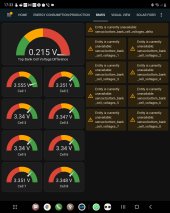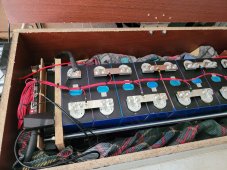Ucatchmydrift
New Member
- Joined
- Jul 2, 2022
- Messages
- 195
Hi, i have two 24v lifepo4 banks in parallel (via busbars). They were top balanced when new to 3.65v. I have had them running for 6 months now. Coincidentally? the first cell on both banks seems to run away when all other cells are at about 3.33v (according to the jk bmses).
I have balancing atm set to start when one cell hits 3.35v+. The jk bmses have 2A of balancing, but this is semingly not enough. I have now lowered the inverter boost voltage to 27.1v, which seems the max voltage i can get away with. 27.2v causes the first cells on each bank to hit 3.65v.
In the 6 months i have used the batteries, i dont think i have ever had them charge fully, as im pretty economic with the power i make. So, maybe this is the reason? (i would hope the cells were good in the first place, as are grade a direct from eve via fogstar uk..)
Just wondering the best way to tackle this? (without haiving to top balance every 6 months!)
Drain some power using a resistor or a small load on each of the first of the cells when at a high state of charge?
Thanks ??




All the connections should be good, and are new, nickel plated bussbars etc as above..
I have balancing atm set to start when one cell hits 3.35v+. The jk bmses have 2A of balancing, but this is semingly not enough. I have now lowered the inverter boost voltage to 27.1v, which seems the max voltage i can get away with. 27.2v causes the first cells on each bank to hit 3.65v.
In the 6 months i have used the batteries, i dont think i have ever had them charge fully, as im pretty economic with the power i make. So, maybe this is the reason? (i would hope the cells were good in the first place, as are grade a direct from eve via fogstar uk..)
Just wondering the best way to tackle this? (without haiving to top balance every 6 months!)
Drain some power using a resistor or a small load on each of the first of the cells when at a high state of charge?
Thanks ??




All the connections should be good, and are new, nickel plated bussbars etc as above..


